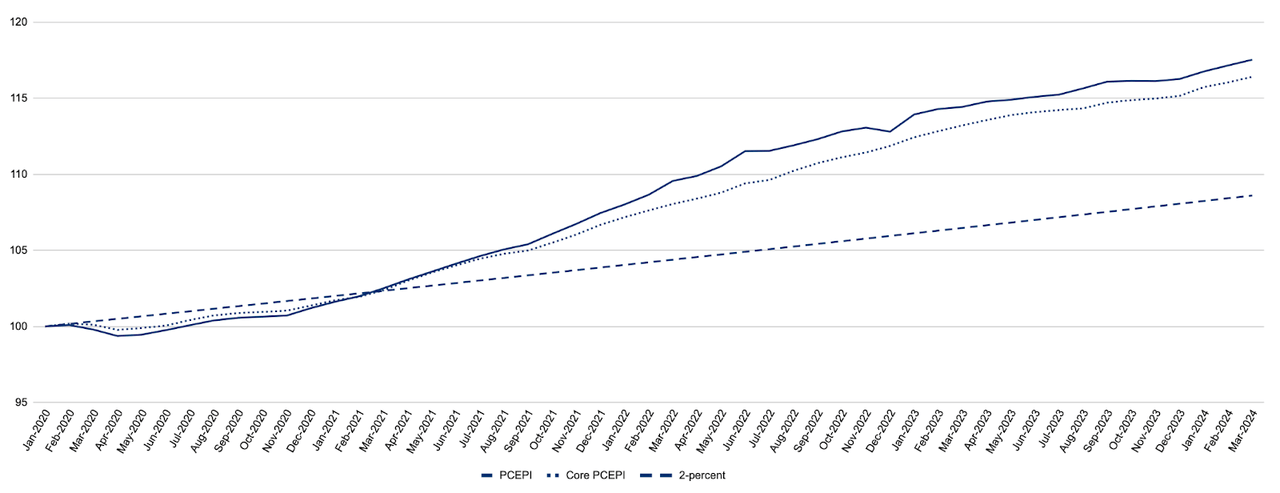By William J. Luther
Inflation is once again on the decline, new data from the Bureau of Economic Analysis (BEA) show. The Personal Consumption Expenditures Price Index (PCEPI), which is the Federal Reserve’s preferred measure of inflation, grew at a continuously compounding annual rate of 3.9 percent in March. It grew at an annualized rate of 5.1 percent in January and 4.0 percent in February.
The renewed disinflation is certainly better than the alternative. But it is nonetheless difficult to celebrate: inflation remains well above the Fed’s 2-percent average inflation target. Prices today are 8.9 percentage points higher than they would have been had they grown at an annualized rate of 2.0 percent since January 2020.

Figure 1. Headline and Core Personal Consumption Expenditures Price Index with 2-percent Trend, January 2020 – March 2024
Core inflation, which excludes volatile food and energy prices, also remained elevated. Core PCEPI grew at a continuously compounding annual rate of 3.8 percent in March. It has grown at an annualized rate of 4.3 percent over the last three months and 2.9 percent over the last six months.
The latest numbers will do little to sway members of the Federal Open Market Committee (FOMC), who are set to meet next week. “We’ve said at the FOMC that we’ll need greater confidence that inflation is moving sustainably toward 2 percent before it would be appropriate to ease policy,” Fed Chair Jerome Powell said on April 16. “If higher inflation does persist, we can maintain the current level of restriction for as long as needed.”
New York Fed President John Williams expressed a similar view on April 18:
I think we’ve got interest rates in a place that is moving us gradually to our goals, so I definitely don’t feel urgency to cut interest rates. I think that monetary policy is doing exactly what we’d like to see. Over time, the data will inform our decisions. I think, eventually, my expectation is as inflation gets all the way to 2 percent on a sustained basis, as the economy is in good balance, interest rates will need to be lower at some point. But the timing of that’s driven by the economy.
Williams said the economic data “are strong on the labor market and GDP and spending.” On inflation, he said, “it’s a little bit of a bumpy road. But, overall, the trend is — the inflation has gradually coming [sic] down.”
FOMC members entered the blackout period on April 20 and, hence, have not offered comments on the latest data. But it seems very unlikely that the observed disinflation would change their tune.
Market participants continue to expect the Fed will cut its federal funds rate target this year — just not anytime soon. The CME Group reports a 70.1 percent chance that the federal funds rate target range will remain at 5.25 to 5.5 percent following the July meeting. But the odds fall to 42.1 percent for the September meeting, 32.6 percent for the November meeting, and just 20.0 percent for the December meeting.
Market participants also doubt that rates will fall as far as Fed officials have projected. In March, the median FOMC member projected the federal funds rate target range would fall to 4.5 to 4.75 percent. The CME Group, however, reports an 88.6 percent chance that the federal funds rate target will exceed that range following the December meeting.
FOMC members will almost certainly vote to hold their target rate constant next week. The real question is whether they will offer any additional guidance on when they might begin to cut the target rate and how quickly the target rate might fall. At present, it seems likely that rates will remain high for some time. But that could change quickly if real economic activity were to falter.
Original Post
Editor’s Note: The summary bullets for this article were chosen by Seeking Alpha editors.
Read the full article here












